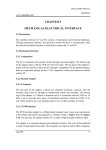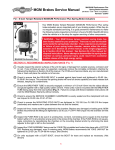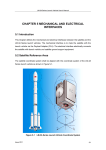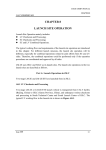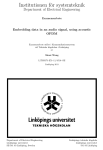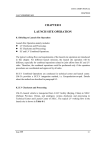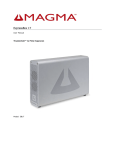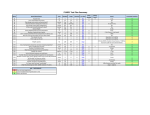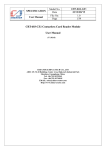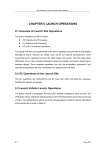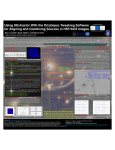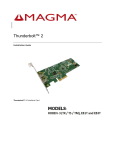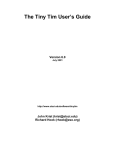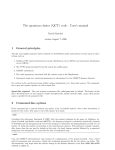Download Chapter 5 Mechanical & Electrical Interfaces
Transcript
LM-2E USER’S MANUAL CHAPTER 5 CALT'S PROPRIETARY CHAPTER 5 MECHANICAL/ELECTRICAL INTERFACE The interface between LV and SC consists of mechanical and electrical interfaces. Through mechanical interface, the SC is mated with the LV mechanically, while the electrical interface functions to electrically connect the LV with SC. In this chapter, interfaces of LM-2E/ETS and LM-2E/EPKM are focused on. Part A: Mechanical/Electrical Interface Provided by LM-2E/ETS A5.1 LM-2E/ETS Mechanical Interface A5.1.1 Summary LM-2E/ETS provides two types of mechanical interface: Type A and Type B. Type A mechanical interface is used for connecting SCs laterally, while Type B for connecting SCs from their bottom. A5.1.2 Type A Mechanical Interface The SCs are connected to the dispenser laterally, and the dispenser is bolted on the main structure of OMS that is connected with payload adapter by clampband. See Figure A5-1. Note: 1) OMS stands for orbital maneuver system; 2) ETS consists of OMS and Dispenser; Issue 1999 5-1 LM-2E USER’S MANUAL CHAPTER 5 CALT'S PROPRIETARY Spacecraft Dispenser Spacecraft Orbital Maneuver System (OMS) Payload Adapter Figure A5-1 Type A Mechanical Interface z Type A SC Dispenser The SC dispenser functions to fasten and release the satellites. The typical type A SC dispenser is composed of a cylinder and a cone made from frame-skin semi-monocoque structure. The specific design is program dependent. The dispenser is fixed on the main structure of OMS by bolts. The SCs are connected with the dispenser by low-shock explosive nuts and separation springs. See Figure A5-2a&b. Issue 1999 5-2 LM-2E USER’S MANUAL CHAPTER 5 CALT'S PROPRIETARY A Explosive Nut Flight Direction TBD Separation Spring SC TBD Dispenser TBD B Direction A Direction B Dispenser Dispenser I SC A A III SC II Figure A5-2a Type A SC Dispenser Issue 1999 5-3 LM-2E USER’S MANUAL CHAPTER 5 CALT'S PROPRIETARY z Separation Device for Type A Dispenser The SC/LV separation device consists of explosive nuts and separation springs as shown in Figure A5-2b. The explosive nuts are used for locking and unlocking the SCs. Catchers can collect the separated bolts. The separation springs includes springs, bracket, pushing rod, etc. The device can provide a SC/LV separation velocity according to user's requirements. Detail II Detail I C Detail III View C Separation Plane Interface Plane Spheric Head Explosive Nut TBD TBD Bolt Catcher 100 Figure A5-2b Separation Device for Type A SC dispenser Issue 1999 5-4 LM-2E USER’S MANUAL CHAPTER 5 CALT'S PROPRIETARY A5.1.3 Type B Mechanical Interface The SCs are connected to the dispenser from their bottom, and the dispenser is fixed on the main structure of OMS, which is connected with payload adapter by clampband. See Figure A5-3. There are 4 SC adapters fixed on the main structure of the typical type B dispenser. The SCs are mounted on the SC adapters by low-shock explosive nuts and separation springs. Spacecraft Spacecraft Dispenser Orbit Maneuver System Payload Adapter Figure A5-3 Configuration of Type B Mechanical Interface z Type B Dispenser The type B dispenser is a short reverse cone structure with four SC adapters as shown in Figure A5-4a. The SC adapter is fastened to the SC adapter at its bottom using explosive nuts. All the separation system except for bolt catcher is attached on the SC adapter. Issue 1999 5-5 LM-2E USER’S MANUAL CHAPTER 5 CALT'S PROPRIETARY SC Adapter II I III I IV Figure A5-4a Type B Dispenser (1) Issue 1999 5-6 LM-2E USER’S MANUAL CHAPTER 5 CALT'S PROPRIETARY Detail I A A Section A-A SC Adapter Separation Spring Bracket Figure A5-4bType B Dispenser (2) Issue 1999 5-7 LM-2E USER’S MANUAL CHAPTER 5 CALT'S PROPRIETARY z Separation System The separation system consists of explosive nuts and separation springs. See Figure A5-4c. The explosive nuts are used for locking and unlocking the SCs. The separation springs includes springs, bracket, pushing rod, etc. The catcher can collect the separated bolts. The separation system can provide a SC/LV separation velocity according to user's requirements. SC Bolt Catcher SC/LV Separation Plane Explosive Nut Separation Spring Separation Spring Bracket Figure 5-4c Separation System for Type B Dispenser Issue 1999 5-8 LM-2E USER’S MANUAL CHAPTER 5 CALT'S PROPRIETARY A5.2 LM-2E/ETS Electrical Interface The SC is electrically connected with SC's electrical ground support equipment (EGSE) through In-flight-disconnectors (IFDs) and umbilical cables provided by LV side. By using of EGSE and the umbilical cables, SC team can perform wired testing and pre-launch control to the SC, such as SC power-supply, on-board battery charging, wired-monitoring on powering status and other parameters. A5.2.1 In-Flight-Disconnectors (IFDs) z Quantity Typically, there are two IFDs mounted on the dispenser for each SC. The detailed location will be coordinated between SC and LV sides and finally defined in ICD. z IFD Supply Generally, the IFDs are selected and provided by the user. CALT is responsible to solder IFDs to the umbilical cables. The necessary operation and measurement description shall also be provided. (If the user selects the China-made connectors, CALT will provide the halves installed on the SC side.). The available China-made connectors are YF8-64 (64 pins), FD- 20(20 pins), FD-26(26 pins), FD-50(50 pins), etc. z Separation signal through IFDs There are four break-wires on the two IFDs for each SC, which generate SC/LV separation signals. The SC will receive the SC/LV separation signals once the break-wires circuitry break while SC/LV separates. In the same way, there are four break-wires on the IFDs. The IFDs will send the SC/Dispenser separation signal to LV once the break-wires circuitry break while SC/Dispenser separates. This separation signal will be sent to LV’s telemetry system through EY1 interface. The break-wire’s allowable current: ≤100mA, allowable voltage: ≤30V. Issue 1999 5-9 LM-2E USER’S MANUAL CHAPTER 5 CALT'S PROPRIETARY A5.2.2 Umbilical System The umbilical system consists of onboard-LV Parts and ground parts. Refer to Figure A5-5 and Figure A5-6. The cable from Launch Control Console (LCC) to Umbilical Tower, EB26/EB36, BOX3, BOX4, and Power-supplies 1&2 are the common for different missions. The onboard-LV cable, as well as ground cable from WXTC to ED 13,14&15 and BOX1 & BOX2, will be designed for dedicated SC according to user's needs. In order to assure the quality of the product, the umbilical system will be provided to the user after pre-delivery acceptance test and insulation/conductivity checkouts in the launch site. Dispenser J12 P12 Pn2 SC1 Jn2 SCn J11 P11 EC1 Pn1 Jn1 EC2 Payload Adapter WXTC To GSE Figure A5-5 LM-2E/ETS Onboard-LV Electrical Interface Issue 1999 5-10 LM-2E USER’S MANUAL CHAPTER 5 CALT'S PROPRIETARY SC1 SCn J11 J12 Jn1 Jn2 P11 P12 Pn1 P n2 Onboard-LV Umbilical Part EC1 EY1 EC2 G1 WXTC EB26 ED13 ED14 ED15 BOX 1 ED23 X1 ED22 ED24 Power Supply1 EB37 EB36 BOX3 EB33 EB46 Ground Umbilical Part Power Supply2 EB56 X31 BOX 2 P5 ED43 ED42 ED44 P6 P7 DLWX P1 J1 SC Console P2 J2 P3 J3 WK BOX4 P8 WZT P4 J4 SC RPS Figure A5-6 Onboard-LV and Ground Umbilical System Issue 1999 5-11 LM-2E USER’S MANUAL CHAPTER 5 CALT'S PROPRIETARY A5.2.2.1 Onboard-LV Umbilical Cable z Composition The Onboard-LV cable net comprises the cables from the IFDs to WXTC. These umbilical cables will fly with LV. Whereas: Code P11,P12…Pn1,Pn2 EC1、EC2 EY1 WXTC G1 Description LV/SC electrical connectors at LV side which is crimp-connected to the cables. Technological interfaces between Dispenser and OMS. Interface between umbilical cable and LV TM system, through which the LV/SC separation signal is sent to LV TM system Umbilical cable connector (LV-Ground) Grounding points to overlap the shielding of wires and the shell of LV Refer to Figure A5-6. z Umbilical Cable Design SC side shall specify characteristics of the IFDs. The specific contents are pin assignment, usage, maximum voltage, maximum current, one-way maximum resistance etc. CALT will design the umbilical cable according to the specified requirements. z Types and Performance of Umbilical Cable Generally, ASTVR and ASTVRP wires are adopted for the onboard-LV cable net: ASTVR, 0.5mm2, fiber-sheath, PVC insulation; ASTVRP, 0.5mm2, fiber-sheath, PVC insulation, shielded. For both cables, their working voltage is ≤500V and DC resistance is 38.0Ω/km (20°C). The single core or cluster is shielded and sheathed. Issue 1999 5-12 LM-2E USER’S MANUAL CHAPTER 5 CALT'S PROPRIETARY A5.2.2.2 Ground Umbilical System z Composition The ground umbilical cable net consists of umbilical cable connector (WXTC), cables, box adapters, etc. Refer to Figure A5-6. Whereas: Code WXTC BOX1 BOX2 BOX3 BOX4 Issue 1999 Description WXTC is umbilical cable connector (LV-Ground) whose female half (socket) is installed at the wall of the VEB, while the male half (pin) is attached to the top end of ground cable. The disconnection of WXTC is electrically controlled. (The disconnection is powered by BOX 3 and controlled by BOX 4. In the mean time, forced disconnection is also used as a spare separation method.) Generally, WXTC disconnects at about 8min prior to launch. If the launch was terminated after the disconnection, WXTC could be reconnected within 30min. The SC should switch over to internal power supply and cut off ground power supply at 5 minutes prior to WXTC disconnection. Therefore, during disconnection only a low current monitoring signal (such as 30V, ≤100mA) is permitted to pass through the WXTC. BOX 1 is a box adapter for umbilical cable that is located inside the Payload Cable Measurement Room on the umbilical tower. Refer to Chapter 7. (If needed, BOX 1 can provide more interfaces for the connection with SC ground equipment.) BOX 2 is another box adapter for umbilical cable that is located inside the Underground Power-supply Room. Refer to Chapter 7. Other SC ground support equipment (RPS, Console, etc.) are also located inside the Underground Power-supply Room. This is a relay box for the disconnection of the umbilical cable. BOX 3 is located inside the Underground Power-supply Room. Box 3 is powered by 2 DC regulated power supply sets. These two power supply sets are in “working-state” sparing to each other. BOX 4 is located inside the Payload Cable Measurement Room . It is for the control of the pre-launch disconnection of SC umbilical cables. 5-13 LM-2E USER’S MANUAL CHAPTER 5 CALT'S PROPRIETARY z Interface on Ground Generally, there are four interfaces on ground, namely, two for SC Console (P1/J1&P2/J2), and the other two for SC power supply (P3/J3&P4/J4). SC side will define the detailed requirement of ground interfaces. Those connectors (P1,P2,P3,P4) to be connected with SC ground equipment should be provided by SC side to LV side for the manufacture of cables. Location Code LV side interfaces P1 P2 P3 P4 Specification Quantity To be defined by SC side 2 2 2 2 If LV side couldn’t get the connectors from SC side, this ground interface cable will be provided in cores with pin marks. SC side can also provide this ground cable. The length of this cable is about 5 meters. If so, LV side will provide the connectors to connect with BOX 2. z Type & Performance of Umbilical Cable Single-Core Shielded Cable Woven wire net for shielding of cable; Working voltage: ≤60V; DC resistance (20°C) of each core: 38.0Ω/km. Function: common control and signal indicating. Ordinary Insulation Cable No shielding for each core, woven tin-plated copper wire for shielding of cable; Working voltage: ≤110V; DC resistance (20°C) of each core: 28.0Ω/km. Function: SC's power supply and battery charging. Twin-twist Shielded Cable Each twisted pair is shielded and the whole cable has a woven wire net for shielding. Impedance: 100Ω. Function: SC data transmission and communication. Under normal condition, the umbilical cable (both onboard-LV and ground) has a insulation resistance of ≥10MΩ (including between cores, core and shielding, core and LV shell) Issue 1999 5-14 LM-2E USER’S MANUAL CHAPTER 5 CALT'S PROPRIETARY The umbilical system can be dedicatedly designed according to the user's requirements. A5.2.3 Umbilical Cable Disconnect Control LV side is responsible for the pre-launch disconnection of umbilical cable through BOX3 and BOX 4. Inside the underground Power Supply Room, there are two DC regulated power supply which will provide power for the cables. They are all in working condition sparing to each other. Generally, according to the count-down launch procedure, only after LV side has received the confirmation that SC has turned to internal power and SC is normal, could the order of umbilical cable disconnection be sent out. A5.2.4 Anti-lightning, Shielding and Grounding In order to assure the safety of the operations of both LV and SC, some measures have been taken for anti-lightning, shielding and grounding. (1) The cable has two shielding layers, the outer shielding is for anti-lightning while the inner shielding is for anti-interference. (2) For the cables from WXTC to BOX 2, the outer shielding (anti-lightning) has a grounding point every 20m. These grounding measures can assure the lightning and other inductance to be discharged immediately. The grounding locations are either on the swing rods or the cable’s supporting brackets. (3) The inner shield has a single grounding. The inner shields of the on-board cables are connected to BOX 2 through WXTC. BOX 2 has a grounding pole. (4) The inner and outer shields are insulated with each other inside the cables. SPECIAL STATEMENT Any signal possibly dangerous to the flight can not be sent to the SCs during the whole flight till LV/SC separation. Only LV/SC separation can be used as the initial reference for all SC operations. After LV/SC separation, SC side can control SC through microswitches and remote commands. Issue 1999 5-15 LM-2E USER’S MANUAL CHAPTER 5 CALT'S PROPRIETARY A5.3 RF Links A5.3.1 RF Path JSLC can provide RF link from technical center to the umbilical tower. Refer to Figure A5-7. SC T&C RF Field Dispenser RF Links J12 P12 Pn2 Jn2 SC 1 BS2 SC n J11 P11 Pn1 Jn1 EC1 EC2 EGSE WXTC TO BOX3 40m BOX1 ED26 ED13 ED14 ED15 X1 ED23 ED24 ED22 BLOCKHOUSE G1 EY1 LV Telemetry System Interface SC CONTROL ROOM 350m SC Console SC RPS CLTC is repsonisble for connection. J1 P1 P5 J2 P2 P6 J3 P3 P7 J4 P4 P8 X31 BOX2 ED43 ED44 ED42 Underground Umbilical Cables Figure A5-7 RF Links in JSLC Issue 1999 5-16 LM-2E USER’S MANUAL CHAPTER 5 CALT'S PROPRIETARY A5.3.2 Characteristics of RF Link (1) Frequency C Band: Ku Band: Up-link: 5925~6425 MHz Down-link: 3700~4200 MHz TBD (2) Signal Level C Band: See following table Ku Band: TBD Frequency Telemetry Command SC Antenna EIRP PFD 37dBm -85dBW/m2 EGSE Input -70dBm Output 30dBm SPECIAL STATEMENT A mission dedicated RF working plan will be worked out. Anyway, the SC RF equipment should be turned off during the whole flight phase of LV until all SCs are separated form the LV hardware. Issue 1999 5-17 LM-2E USER’S MANUAL CHAPTER 5 CALT'S PROPRIETARY Part B: Mechanical/Electrical Interface Provided by LM-2E/EPKM B5.1 LM-2E/EPKM Mechanical Interface B5.1.1 Summary As shown in Figure B5-1, the SC adapter is connected with the SC on the top, and bolted with EPKM on the bottom. EPKM is bolted with the interface adapter, which is connected with LV adapter by clampband. When the clampband is released, the EPKM/SC stack, together with interface adapter, separates from LV adapter. The SC adapter connects with EPKM by 100 bolts. In general, SC will control the EPKM flight as well as EPKM/SC separation. CALT is willing to satisfy other requirements. Spacecraft SC Adapter EPKM Interface Adapter LV Adapter Figure B5-1 LM-2E/EPKM Mechanical Interface Overview Issue 1999 5-18 LM-2E USER’S MANUAL CHAPTER 5 CALT'S PROPRIETARY B5.1.2 LV Adapter LV adapter is an 895mm-high truncated cone, whose top ring diameter is 1868mm and bottom ring diameter is 3184mm. Refer to Figure B5-2. 0.5 A 0.4 B 0.5 A 895 1 φ1868 0.2 142.5 0.3 0.4 φ0.2 A φ3184 1.0 39 25' Overhead View III 6 Separation spring brackets 2 Umbilical connector brackets 60 φ21 30 26 II IV 45 3' 1 Rate Gyro I Figure B5-2 LV Adapter Issue 1999 5-19 LM-2E USER’S MANUAL CHAPTER 5 CALT'S PROPRIETARY B5.1.3 Interface Adapter LV adapter is a truncated cone, whose top ring diameter is 1868mm and bottom ring diameter is 3184mm. Refer to Figure B5-3. φ1760 φ1868 0.2 A 35 0.3 0.3 A Overhead View 6 Separation spring brackets III 30 2 Umbilical connector brackets 30 φ21 26 30 II IV I Figure B5-3 Interface Adapter Issue 1999 5-20 LM-2E USER’S MANUAL CHAPTER 5 CALT'S PROPRIETARY B5.1.4 EPKM/SC Interface A B A 1170 B 2928 1886 376 117 The top ring of EPKM is connected with SC adapter with 100 bolts as shown in Figure B5-4. φ1256 1700 Section A-A Section B-B 4-φ 5 100-M6-5H 0.12 B φ0.03 A φ1728 φ1728 Figure B5-4 EPKM/SC Interface Issue 1999 5-21 LM-2E USER’S MANUAL CHAPTER 5 CALT'S PROPRIETARY B5.1.5 SC Adapter 650 0.8 CALT can provide 1194 adapter as shown in Figure B5-5a&b. 0.2 +Y 6 Separation Springs 7.5 Zoom A 60 60 A 37.5 A -Z +Z 50 39O 1O 2 Explosive Bolts 2 Microswitches -Y Figure B5-5a SC Adapter (1) Issue 1999 5-22 LM-2E USER’S MANUAL CHAPTER 5 CALT'S PROPRIETARY Zoom A 5+0 .05 +Y R603.5 +0.2 0 15 +Z Section A-A 0.08 φ1215 0.2 A 3.2 +0.26 0 3.2 φ1192 φ1131 0.5 A 0.2515 4 15 5 1.6 5 +0.3 0 R1.5 Figure B5-5b SC Adapter (2) Issue 1999 5-23 LM-2E USER’S MANUAL CHAPTER 5 CALT'S PROPRIETARY B5.1.6 SC/EPKM Separation System CALT can provide SC/EPKM separation system. The SC/EPKM separation system consists of clampband system and separation springs. The clampband system is used for locking and unlocking SC adapter and the SC. The separation springs are mounted on the SC adapter, which provides relative velocity between the SC and EPKM. Refer to Figure B5-6a,b,c,d&e. Non-contamination Explosive Bolt Lateral Restraining Springs Clampband Longitudinal Restraining Springs Y Separation Spring Z -Z -Y Figure B5-6a SC/EPKM Separation System Issue 1999 5-24 LM-2E USER’S MANUAL CHAPTER 5 CALT'S PROPRIETARY Clampband Dynamic Envelope +Z φ1495 Clampband Explosive Bolt +Y -Y -Z 1315 Figure B5-6b Clampband Dynamic Envelope Issue 1999 5-25 LM-2E USER’S MANUAL CHAPTER 5 CALT'S PROPRIETARY Detail A SC Interface Ring Bolt Payload Adapter Clampband V Shoe V Shoe Detail B C C Clampband Section C-C Explosive Bolt 100 63 Lateral Restraining Spring Figure B5-6c Clampband in Detail Issue 1999 5-26 LM-2E USER’S MANUAL CHAPTER 5 CALT'S PROPRIETARY Section A-A SC Interface Ring Clampband 2 Mircoswitches Payload Adapter Section B-B φ 1155 Clampband SC Interface Ring Payload Adapter Longitudinal Restraining Spring Pushing Rod Separation Spring Figure B5-6d SC/EPKM Separation Spring Issue 1999 5-27 LM-2E USER’S MANUAL CHAPTER 5 CALT'S PROPRIETARY Section A-A 4 SC/LV Separation Plane Payload Adapter 2 Microswitches (Extending Status) Bracket φ 1155 SC/LV Separation Plane Payload Adapter Pushing Rod Separation Spring (Extending Status) Figure B5-6e SC/EPKM Separation Spring (Extending Status) Issue 1999 5-28 LM-2E USER’S MANUAL CHAPTER 5 CALT'S PROPRIETARY B5.2 LM-2E/EPKM Electrical Interface The SC is electrically connected with SC's electrical ground support equipment (EGSE) through SC/LV In-flight-disconnectors (IFDs) and umbilical cables provided by LV side. In general, SC will control SC/EPKM separation, the SC adapter will separate from SC together with EPKM. The actual electrical interface between LV and SC is defined at the interface between LV and EPKM, i.e. the top of the interface ring. By using of EGSE and the umbilical cables, SC team can perform wired testing and pre-launch control to the SC, such as SC power-supply, on-board battery charging, wired-monitoring on powering status and other parameters. B5.2.1 In-Flight-Disconnectors (IFDs) z Quantity Typically, there are two IFDs symmetrically mounted outside the top ring of the interface adapter. The detailed location will be coordinated between SC and LV sides and finally defined in ICD. z IFD Supply Generally, the IFDs are selected and provided by the user. CALT is responsible to solder IFDs to the umbilical cables. The necessary operation and measurement description shall also be provided. (If the user selects the China-made connectors, CALT will provide the halves installed at the SC side.)The available China-made connectors are YF8-64 (64 pins), FD- 20(20 pins), FD-26(26 pins), FD-50(50 pins), etc. z Separation Signal through IFDs There are four break-wires on the two IFDs for each SC, which generate EPKM/LV separation signals. The SC will receive the EPKM/LV separation signals once the break-wires circuitry break while EPKM/LV separates. In the same way, there are two break-wires on the IFDs J1 & J2. The IFDs will send the EPKM/LV separation signal to LV once the break-wires circuitry break while EPKM/LV separates. This separation signal will be sent to LV’s telemetry system through EY1 interface. The break-wire’s allowable current: ≤100mA, allowable voltage: ≤30V. Issue 1999 5-29 LM-2E USER’S MANUAL CHAPTER 5 CALT'S PROPRIETARY B5.2.2 Umbilical System The umbilical system consists of onboard-LV Parts and ground parts. Refer to Figure B5-5, Figure B5-6 and Figure B5-7. The 350m-cable from Launch Control Console (LCC) to Umbilical Tower, EB26/EB36, BOX3, BOX4, and Power-supply 1&2 are the common to different missions. The onboard-LV cable, as well as ground cable from WXTC to ED 13,14&15 and BOX1 & BOX2, will be designed for dedicated SC according to User's needs. In order to assure the quality of the product, the umbilical system will be provided to the User after pre-delivery acceptance test and insulation/conductivity checkouts in the launch site. CS2 CS4 CS1 SAID CS3 EC4 EC1 EC5 EC2 WXTC Ground Disarm Control Box Figure B5-5 LM-2E/EPKM Electrical Interface Issue 1999 5-30 LM-2E USER’S MANUAL CHAPTER 5 CALT'S PROPRIETARY CS2 CS5A Onboard-LV Umbilical Part CS1 CS4 CS5 EY2 SAID EC1 EC4 CS3 EY1 WFC2 WFC3 EC2 EY3 EC5 WXTC ED23 ED24 ED22 Underground Power Room 8E535-3B Power Supply1 36V10A KSEYVP-6 2 0.75 KYVRP-1 108 0.75 KYVRPP 80 0.5 Ground Umbilical Part EB26 ED13 ED14 ED15 X1 KYVRP-1 108 0.75 BOX 1 EB37 EB36 BOX3 EB33 EB46 Power Supply2 36V10A EB56 X31 BOX 2 P5 ED43 ED44 P6 5m .1897 5m .1898 5m .1899 5m P7 P1 J1 SC Console ED42 P8 8E536-3B P2 J2 P3 J3 BOX4 WK 8E70-3B WZT DLWX P4 J4 SC RPS Figure B5-6 Umbilical Cable for SC Issue 1999 5-31 LM-2E USER’S MANUAL CHAPTER 5 CALT'S PROPRIETARY B5.2.2.1 Onboard-LV Umbilical Cable z Composition The Onboard-LV cable net comprises the cables from the IFDs (P1, P2) to WXTC. These umbilical cables will fly with LV. Whereas: Code P1、P2 EC1、EC4 EY1 WXTC G1 Description LV/SC electrical connectors at LV side which is crimp-connected to the cables. Technological interfaces between SC adapter and LV Interface between umbilical cable and LV TM system, through which the EPKM/LV separation signal is sent to LV TM system Umbilical cable connector (LV-Ground) Grounding points to overlap the shielding of wires and the shell of LV Refer to Figure B5-6. z Umbilical Cable Design SC side shall specify characteristics of the IFDs. The specific contents are pin assignment, usage, maximum voltage, maximum current, one-way maximum resistance etc. CALT will design the umbilical cable according to the specified requirements. z Types and performance of Umbilical Cable Generally, ASTVR and ASTVRP wires are adopted for the onboard-LV cable net: ASTVR, 0.5mm2, fiber-sheath, PVC insulation; ASTVRP, 0.5mm2, fiber-sheath, PVC insulation, shielded. For both cables, their working voltage is ≤500V and DC resistance is 38.0Ω/km (20°C). The single core or cluster is shielded and sheathed. Issue 1999 5-32 LM-2E USER’S MANUAL CHAPTER 5 CALT'S PROPRIETARY B5.2.2.2 Ground Umbilical Cable Net z Composition The ground umbilical cable net consists of umbilical cable connector (WXTC), cables, box adapters, etc. Refer to Figure B5-6 and Figure B5-7. Whereas: Code WXTC BOX1 BOX2 BOX3 BOX4 Issue 1999 Description WXTC is umbilical cable connector (LV-Ground) whose female half (socket) is installed at the wall of the VEB, while the male half (pin) is attached to the top end of ground cable. The disconnection of WXTC is electrically controlled. (The disconnection is powered by BOX 3 and controlled by BOX 4. In the mean time, forced disconnection is also used as a spare separation method.) Generally, WXTC disconnects at about 8min prior to launch. If the launch was terminated after the disconnection, WXTC could be reconnected within 30min. The SC should switch over to internal power supply and cut off ground power supply at 5 minutes prior to WXTC disconnection. Therefore, during disconnection only a low current monitoring signal (such as 30V, ≤100mA) is permitted to pass through the WXTC. BOX 1 is a box adapter for umbilical cable that is located inside the SC Cable Measurement Room on Floor 8.5 of the umbilical tower. (If needed, BOX 1 can provide more interfaces for the connection with SC ground equipment.) BOX 2 is another box adapter for umbilical cable that is located inside the SC Blockhouse on ground. Other SC ground support equipment (RPS, Console, etc.) are also located inside the Blockhouse. This is a relay box for the disconnection of the umbilical cable. BOX 3 is located inside the under-ground Power-Supply Room. Box 3 is powered by 2 DC regulated power supply sets. These two power supply sets are in “working-state” sparing to each other. BOX 4 is located inside Blockhouse. It is for the control of the pre-launch disconnection of SC umbilical cables. 5-33 LM-2E USER’S MANUAL CHAPTER 5 CALT'S PROPRIETARY z Interface on Ground Generally, there are four interfaces on ground, namely, two for SC Console (P1/J1&P2/J2), and the other two for SC power supply (P3/J3&P4/J4). SC side will define the detailed requirement of ground interfaces. Those connectors (P1,P2,P3,P4) to be connected with SC ground equipment should be provided by SC side to LV side for the manufacture of cables. Location Code LV side interfaces P1 P2 P3 P4 Specification Quantity To be defined by SC side 2 2 2 2 If LV side couldn’t get the connectors from SC side, this ground interface cable will be provided in cores with pin marks. SC side can also provide this ground cable. The length of this cable is about 5 meters. If so, LV side will provide the connectors (as Y11P-61) to connect with BOX 2. z Type & Performance The type and performance of the umbilical cables are listed in Figure B5-6. Single-Core Shielded Cable KYVRPP 80×0.5, Copper core, PV insulation, copper film plating on PV for shielding of each core, PVC sheath, woven wire net for shielding of cable; 80 cores/cable, 0.5mm2/core; Working voltage: ≤60V; DC resistance (20°C) of each core: 38.0Ω/km. Ordinary Insulation Cable KYVRP-1 108×0.75, copper core with PV insulation, PVC sheath, woven wire for shielding, flexible; 108 cores/cable, 0.75mm2/core; No shielding for each core, woven tin-plated copper wire for shielding of cable; Working voltage: ≤110V; DC resistance (20°C) of each core: 28.0Ω/km. Twin-twist Shielded Cable Issue 1999 5-34 LM-2E USER’S MANUAL CHAPTER 5 CALT'S PROPRIETARY KSEYVP 6×2×0.75, 6 pairs of twin-twisted cores, 0.75mm2/core. Each twisted pair is shielded and the whole cable has a woven wire net for shielding. Impedance: 100Ω. Twin-twist shielded cable (KSEYVP) are generally used for SC data transmission and communication. Single-core shielded cable (KYVRPP) is often used for common control and signal indicating. KYVRP-1 cable is adopted for SC’s power supply on ground and multi-cores are paralleled to meet the SC’s single-loop resistance requirement. Under normal condition, the umbilical cable (both on-board and ground) has a insulation resistance of ≥10MΩ (including between cores, core and shielding, core and LV shell) B5.2.3 Umbilical Cable Disconnect Control LV side is responsible for the pre-launch disconnection of umbilical cable through BOX3 and BOX 4. Inside the underground Power Supply Room, there are two 36V/10A DC regulated power supply which will provide power for the cables. They are all in working condition sparing to each other. Generally, according to the count-down launch procedure, only after LV side has received the confirmation that SC has turned to internal power and SC is normal, could the order of umbilical cable disconnection be sent out. B5.2.4 Anti-lightning, Shielding and Grounding In order to assure the safety of the operations of both LV and SC, some measures have been taken for anti-lightning, shielding and grounding. The cable has two shielding layers, the outer shielding is for anti-lightning while the inner shielding is for anti-interference. For the cables from WXTC to BOX 2, the outer shielding (anti-lightning) has a grounding point every 20m. These grounding measures can assure the lightning and other inductance to be discharged immediately. The grounding locations are either on the swing rods or the cable’s supporting brackets. The inner shield has a single grounding. The inner shields of the on-board cables are connected to BOX 2 through WXTC. BOX 2 has a grounding pole. Issue 1999 5-35 LM-2E USER’S MANUAL CHAPTER 5 CALT'S PROPRIETARY The inner and outer shields are insulated with each other inside the cables. B5.2.5 Continuity of SC “Earth-Potential” The SC should have a reference point of earth-potential and this benchmark should be near to the EPKM/LV separation plane. Generally, the resistance between all other metal parts of SC (shell, structures, etc.) and this benchmark should be less than 10mΩ under a current of 10mA. There is also a reference-point of earth-potential at the bottom of the adapter. The resistance between LV reference point at the adapter and SC reference should be less than 10mΩ with a current of 10mA. In order to keep the continuity of earth-potential and meet this requirement, the bottom of SC to be mated with adapter should not be treated chemically or treated through any other methodology affecting its electrical conductivity. SPECIAL STATEMENT Any signal possibly dangerous to the flight can not be sent to the SC during the whole flight till EPKM/LV separation. Only EPKM/LV separation can be used as the initial reference for all SC operations. After EPKM/LV separation, SC side can control SC through microswitches and remote commands. Issue 1999 5-36 LM-2E USER’S MANUAL CHAPTER 5 CALT'S PROPRIETARY B5.3 RF Links B5.3.1 RF Relay Path XSLC can provide RF link from EGSE to SC either in BS or on the umbilical tower. Refer to Figure B5-7. RF LIN K RF LIN K RF LIN K RF On the Hill On the UmbilicalTower LI NK SC T&C RF Field SC CS1 CS4 BS2 EGSE EC2 TO BOX3 J2 P1 P2 WXTC E C5 40m BOX1 J1 ED26 ED13 ED14 ED15 X1 ED23 ED24 ED22 BLOCKHOUSE G1 EY1 LV Telemetry System Interface SC CONTROL ROOM 350m SC Console SC RPS CLTC is epsonisble for connection. J1 P1 P5 J2 P2 P6 J3 P3 P7 J4 P4 P8 X31 BOX2 ED43 ED44 ED42 Underground Umbilical Cables Figure B5-7 RF Links Issue 1999 5-37 LM-2E USER’S MANUAL CHAPTER 5 CALT'S PROPRIETARY B5.3.2 Characteristics of RF Link (3) Frequency C Band: Ku Band: Up-link: 5925~6425 MHz Down-link: 3700~4200 MHz TBD (4) Signal Level C Band: See following table Ku Band: TBD Frequency Telemetry Command SC Antenna EIRP PFD 37dBm -85dBW/m2 EGSE Input -70dBm Output 30dBm SPECIAL STATEMENT A mission dedicated RF working plan will be worked out. Anyway, the SC RF equipment should be turned off during the whole flight phase of LV until all SCs are separated form the LV hardware. Issue 1999 5-38






































